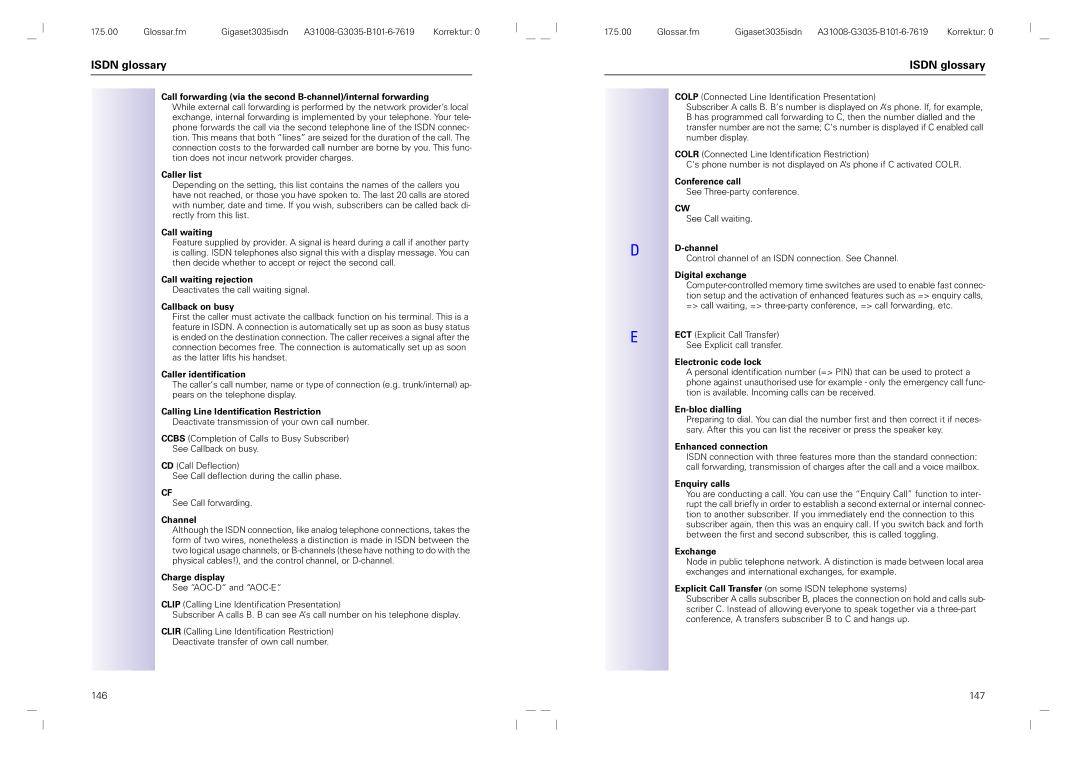
17.5.00 | Glossar.fm | Gigaset3035isdn | Korrektur: 0 |
ISDN glossary
Call forwarding (via the second
While external call forwarding is performed by the network provider’s local exchange, internal forwarding is implemented by your telephone. Your tele- phone forwards the call via the second telephone line of the ISDN connec- tion. This means that both “lines” are seized for the duration of the call. The connection costs to the forwarded call number are borne by you. This func- tion does not incur network provider charges.
Caller list
Depending on the setting, this list contains the names of the callers you have not reached, or those you have spoken to. The last 20 calls are stored with number, date and time. If you wish, subscribers can be called back di- rectly from this list.
Call waiting
Feature supplied by provider. A signal is heard during a call if another party is calling. ISDN telephones also signal this with a display message. You can then decide whether to accept or reject the second call.
Call waiting rejection
Deactivates the call waiting signal.
Callback on busy
First the caller must activate the callback function on his terminal. This is a feature in ISDN. A connection is automatically set up as soon as busy status is ended on the destination connection. The caller receives a signal after the connection becomes free. The connection is automatically set up as soon as the latter lifts his handset.
Caller identification
The caller‘s call number, name or type of connection (e.g. trunk/internal) ap- pears on the telephone display.
Calling Line Identification Restriction
Deactivate transmission of your own call number.
CCBS (Completion of Calls to Busy Subscriber)
See Callback on busy.
CD (Call Deflection)
See Call deflection during the callin phase.
CF
See Call forwarding.
Channel
Although the ISDN connection, like analog telephone connections, takes the form of two wires, nonetheless a distinction is made in ISDN between the two logical usage channels, or
Charge display
See
CLIP (Calling Line Identification Presentation)
Subscriber A calls B. B can see A‘s call number on his telephone display.
CLIR (Calling Line Identification Restriction)
Deactivate transfer of own call number.
146
17.5.00 Glossar.fm Gigaset3035isdn
ISDN glossary
COLP (Connected Line Identification Presentation)
Subscriber A calls B. B‘s number is displayed on A‘s phone. If, for example, B has programmed call forwarding to C, then the number dialled and the transfer number are not the same; C‘s number is displayed if C enabled call number display.
COLR (Connected Line Identification Restriction)
C‘s phone number is not displayed on A’s phone if C activated COLR.
Conference call
See
CW
See Call waiting.
D | ||
| ||
| Control channel of an ISDN connection. See Channel. | |
| Digital exchange | |
| ||
| tion setup and the activation of enhanced features such as => enquiry calls, | |
| => call waiting, => | |
E | ECT (Explicit Call Transfer) | |
See Explicit call transfer. | ||
| ||
| Electronic code lock | |
| A personal identification number (=> PIN) that can be used to protect a | |
| phone against unauthorised use for example - only the emergency call func- | |
| tion is available. Incoming calls can be received. | |
|
| |
| Preparing to dial. You can dial the number first and then correct it if neces- | |
| sary. After this you can list the receiver or press the speaker key. | |
| Enhanced connection | |
| ISDN connection with three features more than the standard connection: | |
| call forwarding, transmission of charges after the call and a voice mailbox. | |
| Enquiry calls | |
| You are conducting a call. You can use the “Enquiry Call” function to inter- | |
| rupt the call briefly in order to establish a second external or internal connec- | |
| tion to another subscriber. If you immediately end the connection to this | |
| subscriber again, then this was an enquiry call. If you switch back and forth | |
| between the first and second subscriber, this is called toggling. | |
| Exchange | |
| Node in public telephone network. A distinction is made between local area | |
| exchanges and international exchanges, for example. | |
| Explicit Call Transfer (on some ISDN telephone systems) | |
| Subscriber A calls subscriber B, places the connection on hold and calls sub- | |
| scriber C. Instead of allowing everyone to speak together via a | |
| conference, A transfers subscriber B to C and hangs up. |
147
